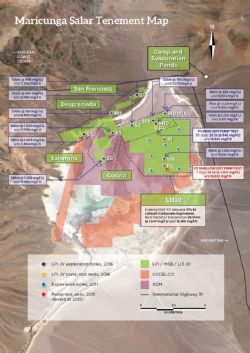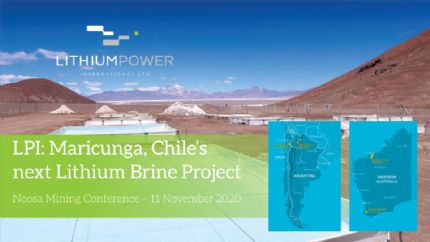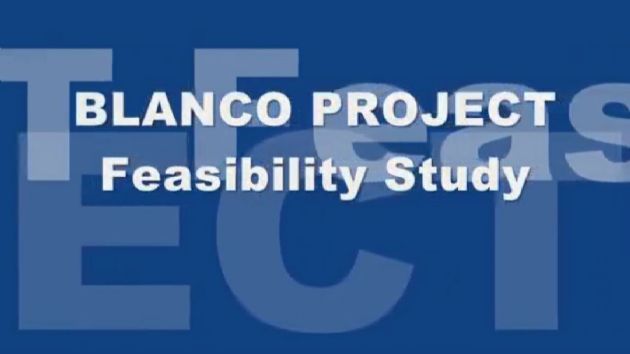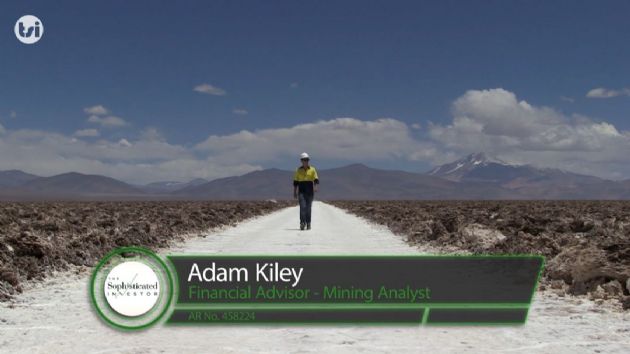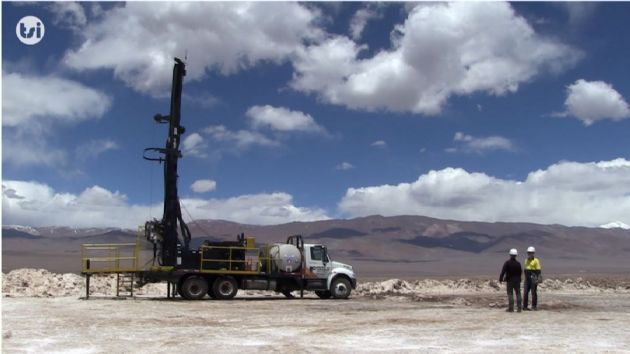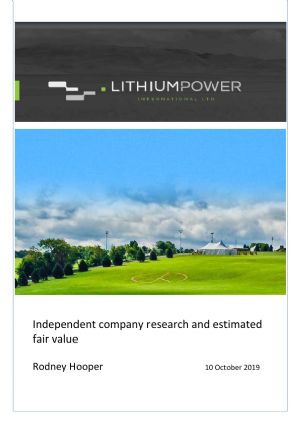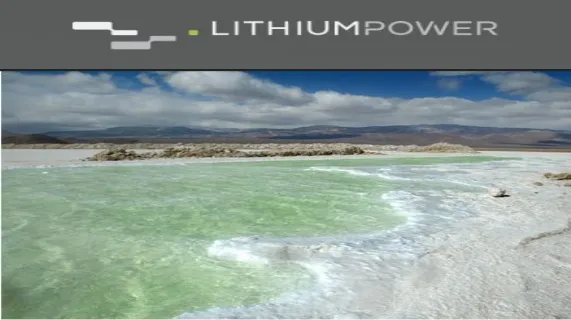
Very High Lithium Brine Flow Rates at Maricunga, Chile
Sydney, May 18, 2017 AEST (ABN Newswire) - Lithium Power International Limited ( ASX:LPI) (
ASX:LPI) ( LTHHF:OTCMKTS) ("LPI" or "the Company") is pleased to advise the results of a pump test completed on well P2 at the Maricunga lithium brine project in northern Chile. This pumping test demonstrated an excellent flow and brine concentration and LPI is very encouraged by the results, which as presented previously, compare very favourably to other lithium brine projects currently in production and in development within South America.
LTHHF:OTCMKTS) ("LPI" or "the Company") is pleased to advise the results of a pump test completed on well P2 at the Maricunga lithium brine project in northern Chile. This pumping test demonstrated an excellent flow and brine concentration and LPI is very encouraged by the results, which as presented previously, compare very favourably to other lithium brine projects currently in production and in development within South America.
- A pump test was completed on the upper 16 m of well P2 in the south of the Litio tenement, with pumping sustained at a constant 45 litres/second over 7 days
- No change in the brine concentration over the pump test, with the brine concentration averaging 1,140 mg/l lithium and 8,322 mg/l potassium over the 7 days of test pumping
- Pump test only extracted brine from the upper salt unit, which contains higher than average grades to potentially sustain early project production
- This test confirms the high brine flows that can be achieved in the project, demonstrating that the upper salt unit supports the highest brine flow rates recorded to data on the project
Maricunga Pump Test Well P2
Pump test well P2 was installed in the south of the Litio tenements to a depth of 150m (see Figure 1) in 2011 with a network of monitoring wells installed surrounding the well. Initial pump testing on the well was conducted in 2015, with the well producing from the upper salt unit and lower aquifer at 37 l/sec over 28 days (LPI announcement 13 September 2016).
To provide specific information on the capacity of the upper salt unit a new pump test was conducted by the MSB joint venture. This involved isolating the filter section of the upper 16 m of the hole with a packer device located at 40 m down the hole in the solid well casing.
With the lower section of the well isolated from the pumping the well was pumped at increasing rates to measure hydraulic parameters and then pumped at a continuous rate of 45 l/sec over 7 days. Over this period there was only a minor decline in the water level.
The upper salt aquifer consists of salt, with some interbeds of clay, which is distinct from the lower aquifer where sand and gravel are of greater importance.
Over the 7 days the brine outflow was continuously monitored for both lithium grade and flow rate.
Assays averaged 1,140 mg/l lithium and showed only minor variation over the length of the test. These test results provide additional information regarding the favourable hydraulic parameters of the Maricunga aquifers. In particular, this test illustrates the potential to achieve high brine flows, at higher than average grades from shallow depths providing significant production advantage in the early years of the project.
As previously noted (LPI announcement 23 February, 2017) flow rates from the Maricunga salar are amongst the highest observed at lithium projects currently in production or at an advanced stage of development.
Salar Permeability
Brine pump tests are important as they provide information on the permeability, lithium grade and flow rates of the different sediment units that host brine within the salar. Further, high flow rates suggest less capex requirement for future well field development, which is attractive for brine project economics. The Maricunga project has an upper aquifer comprising salt, plus a deeper aquifer with sand and gravel units, all of which are favourable for pumping of brine.
Salar Porosity
Porosity is a related characteristic to permeability, and refers to the percentage of pore space between grains of sediment that can host lithium brine. There are several different measures of porosity, but the most important metric for brine deposits is the "drainable porosity". This represents brine that can be extracted from an aquifer during pumping and processed for lithium production. The drainable porosity value is lower for fine grained sediments (clays and silts) and higher for coarser sediments (salt, sands and gravels).
Lithium Power International's Chief Executive Officer, Martin Holland, commented:
"The new Maricunga P2 pump test demonstrated extremely strong brine flow rates from the upper salt unit, in addition to very high lithium grades, both very positive characteristics of the Maricunga project. As we move towards completion of the resource estimate and undertaking engineering studies for the project we look forward to providing information on the project advances."
Maricunga JV Background
The Maricunga JV is 50%-owned by LPI. The project is regarded by LPI management as one of the highest quality undeveloped pre-production lithium brine project globally, with a very high lithium grade and strong flow rates. The company continues to advance towards a new JORC compliant resource estimate by the end of 2Q17, based on results of the drilling & pump testing program, with the project scoping study (Preliminary Economic Assessment) currently underway by consultants Worley Parsons for delivery in late 2017.
To view tables and figures, please visit:
http://abnnewswire.net/lnk/89Z05XQB
About Lithium Power International Ltd
 Lithium Power International Limited (ASX:LPI) is a pure play lithium company with three distinct project regions to provide diversification. One is located in South America's brine region and three are in Australia's spodumene hard rock areas of Western Australia.
Lithium Power International Limited (ASX:LPI) is a pure play lithium company with three distinct project regions to provide diversification. One is located in South America's brine region and three are in Australia's spodumene hard rock areas of Western Australia.
The primary focus is to develop of Chile's next high-grade lithium mine on the Maricunga Salar in an area known as the Lithium Triangle. The Company has also expanded its tenement holdings of lithium exploration prospects in Western Australia.
| ||
|



